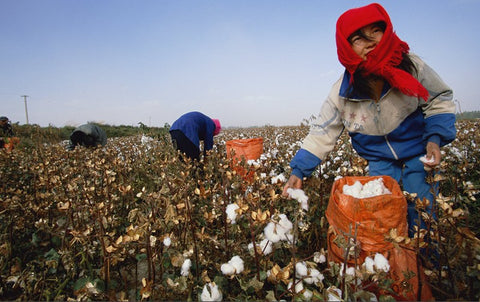To break it down even further- just 1 pound of fabric emits an estimated 7 pounds of CO2 during manufacturing. A single cotton T-Shirt wastes over 700 gallons of water during manufacturing.
The sheer amount of fabric produced each year is a reflection of how much fabric has become such a necessity in our lives. Fabric is all round us, from the clothes we choose to adorn ourselves with to the spaces we dwell in. It’s clear that conventional fabric isn’t going anywhere for the time being, but their impact on the environment cannot be ignored. So what can be done to help stop the negative impact?
Here are a few tips to keep in mind when purchasing clothes, or anything manufactured with fabric.
TIP # 1
AVOID SYNTHETICS
As a general rule of thumb for any eco-conscious fabric lover: STAY AWAY FROM SYNTHETICS.
Here’s why:
- Synthetics do no decompose. They stay in landfills and release heavy metals into the soil and water supply.
- They are MADE from fossil Fuels
- Producing synthetic fibers also produces air pollutants. For Example: Nylon created dangerous levels of N20, which is 3 times more damaging that CO2 and which, because of its long life of 120 years, can reach the upper atmosphere and deplete the layer of stratospheric ozone, which is an important filter of UV radiation.
Side Story: When I was living in Maine, I was selling at a holiday sale and woman came up to me, really loving the textile choices I had chosen for the ties I was selling. We got to talking and she suddenly tells me that her father was the inventor of acrylic fibers for textiles. She then proceeds to tell me that due to the incredibly toxic nature of the production methods, his body became poisoned, cancer ridden and unfortunately died very young. Pretty heavy conversation for a Holiday Sale, but it really opened my eyes to the incredibly toxic nature of some fibers out there. It’s for that reason that MIZU has committed to not use any new synthetic fibers in our designs- and for the very few pieces that do incorporate a small amount synthetic fibers, the fabric is at least 15 years old and never 100% synthetic.
TIP # 2
BUY NATURAL
Natural Fiber fabrics ( Plant fibers - cotton, linen, hemp, etc. Animal fibers- wool, cashmere, angora, ) are far better choice.
Generally speaking, natural fibers have half the carbon footprint of all synthetics. In addition to having a much smaller carbon footprint ( or embodied energy ), natural fibers are bio-degradable. Microorganisms can safely break them down ( dye particles may still be harmful- always choose naturally dyed when possible ). These broken down fibers are essential composted, with all carbon returning to the soil and assisting in regrowth of new plants.
Clothing made from natural fibers or discarded textiles can also be recycled in to anything from paper, cotton rags or seat cushions, depending on the severity of wear and tear. When unsalvageable, natural fiber clothing is easily composted.
TIP # 3
Think of buying vintage as a form of recycling textiles.
Every year, an estimated 13.1 MILLION tons of textiles are trashed and of that, only 15% were reclaimed for recycling! The remaining 11 Million tons of textiles sits to decompose in landfills. Decomposing clothing releases methane, a harmful greenhouse gas and a significant contributor to global warming. There are dyes and chemicals in fabric and other components of clothing and shoes that can leach into the soil, contaminating both surface and groundwater. Additionally, the recycling and waste management process is extremely energy intensive and could very easily double the ‘embodied energy’ already in the fabric.
Keep these textiles out of the landfills- they were already created so you mind as well enjoy them! Besides, fashion is cyclical. They will be back in style.
MIZU is very conscious of our carbon footprint and proudly sources the best
vintage fabrics available in many of our designs. Shop the Earth Day Collection and help reduce your carbon footprint.
TIP # 4
BUY ORGANIC
Organic fibers are wonderful for the environment. Without using synthetic fertilizers, pesticides or GMOS, their carbon footprint almost always the most impressive.
A study published by Innovations Agronomiques (2009) found that 43% less GHG are emitted per unit area under organic agriculture than under conventional agriculture. A study done by Dr. David Pimentel of Cornell University found that organic farming systems used just 63% of the energy required by conventional farming systems, largely because of the massive amounts of energy requirements needed to synthesize nitrogen fertilizers.
However, while still a sustainable, eco-friendly choice, just because it’s organic doesn’t mean it necessarily has a smaller carbon footprint.
As a general rule of thumb, yes, organic fibers DO have less embodied energy, and create less GHG than any other fiber. However, it is all contingent on the area of manufacture. For example- In a study from Stockholm Environment Institute, they found that the total energy to produce organic cotton in India was greater than the conventionally, non-organic cotton produced in the USA.
The reason- yields are much less in India, so it takes much more land ( and employees, and transportation and energy ) to grow the same amount of organic cotton that is grown in places such as the United States. In Addition, much of India’s energy is still driven from coal, a nonrenewable resource.
Organic is great in any capacity- but if you’re going to buy organic, be mindful of where it’s produced.
---
SO-
Be mindful of your fabric choices.
Avoid Synthetics. Buy Natural. Buy Vintage. Buy Organic.


